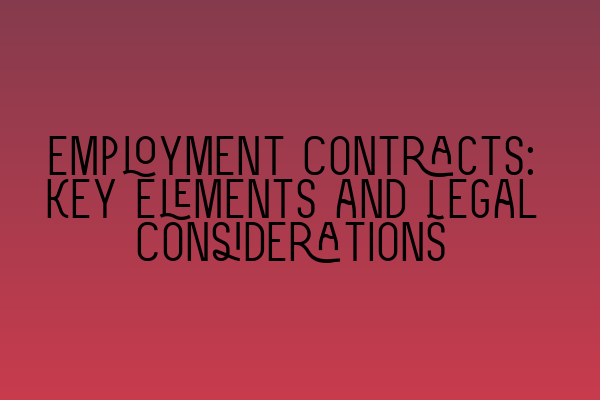Employment Contracts: Key Elements and Legal Considerations
When it comes to hiring employees, one of the most critical documents you need is an employment contract. This legal agreement helps to establish the rights and obligations of both the employer and the employee, ensuring a smooth and mutually beneficial working relationship. In this article, we will delve into the key elements and legal considerations of employment contracts, providing you with a comprehensive understanding of this vital document.
1. Offer and Acceptance
Like any contract, an employment contract begins with an offer and acceptance. The employer makes an offer of employment, and the candidate accepts the offer, usually in writing. This written acceptance serves as evidence of mutual agreement and is crucial in any potential legal disputes that may arise.
Related Article: Interpreting Contractual Clauses: Unlocking the Hidden Meanings
2. Job Description and Duties
An employment contract should clearly outline the job description and the duties and responsibilities expected of the employee. This section should include specific details about the position, such as job title, department, reporting structure, and any special conditions or requirements.
Related Article: Contractual Obligations: Navigating the Responsibilities of Parties
3. Compensation and Benefits
Compensation and benefits are crucial aspects of any employment contract. This section should clearly state the employee’s salary or wage, the frequency of payment, and any applicable bonuses, commissions, or incentives. Additionally, it should outline the employee’s entitlement to benefits such as health insurance, retirement plans, paid time off, and other perks.
4. Working Hours and Leave Policies
The employment contract should specify the employee’s regular working hours, as well as any provisions for overtime and compensation for extra hours worked. It should also outline the company’s leave policies, including vacation days, sick leave, and parental leave, complying with applicable employment laws and regulations.
5. Confidentiality and Non-Disclosure
Confidentiality and non-disclosure clauses are commonly included in employment contracts, particularly for positions that involve access to sensitive information or trade secrets. These clauses serve to protect the employer’s intellectual property and ensure that employees do not disclose confidential information to unauthorized parties.
6. Termination and Notice Period
This section of the employment contract outlines the conditions under which either party may terminate the employment relationship. It should include the notice period required by both the employer and the employee if they decide to end the contract. It may also address grounds for immediate termination, such as misconduct or breach of contract.
Related Article: Discharge of Contracts: Modes and Consequences Explained
7. Dispute Resolution and Governing Law
An employment contract should outline the mechanism for resolving any disputes that may arise between the employer and the employee. This may include mediation, arbitration, or going to court. Additionally, the contract should specify the jurisdiction and governing law that will apply in case of legal disputes.
Conclusion
An employment contract is a vital document that sets the foundation for a successful employer-employee relationship. It protects the rights of both parties and ensures clarity in terms of duties, compensation, and expectations. By including the key elements and legal considerations discussed in this article, you can create a robust employment contract that safeguards your rights as an employer and promotes a positive working environment.
Related Articles:
- Interpreting Contractual Clauses: Unlocking the Hidden Meanings
- Contract Law Tutorials: Simplifying Complex Concepts for Students
- Discharge of Contracts: Modes and Consequences Explained
- Exploring Third Party Rights in Contract Law: Implications and Boundaries
- Contractual Obligations: Navigating the Responsibilities of Parties
